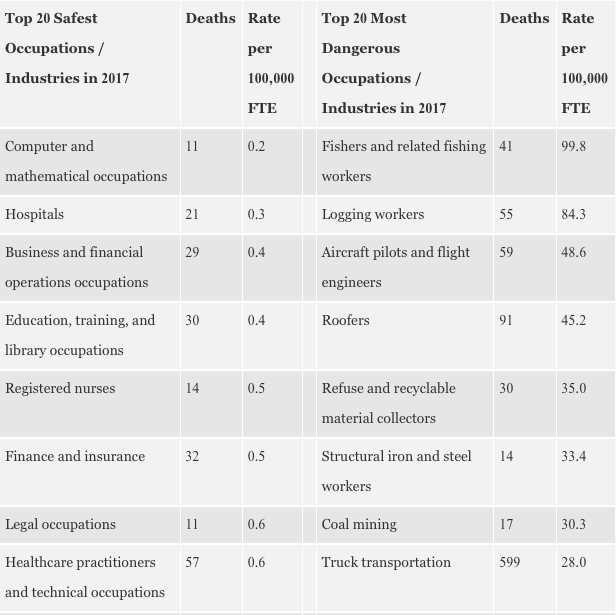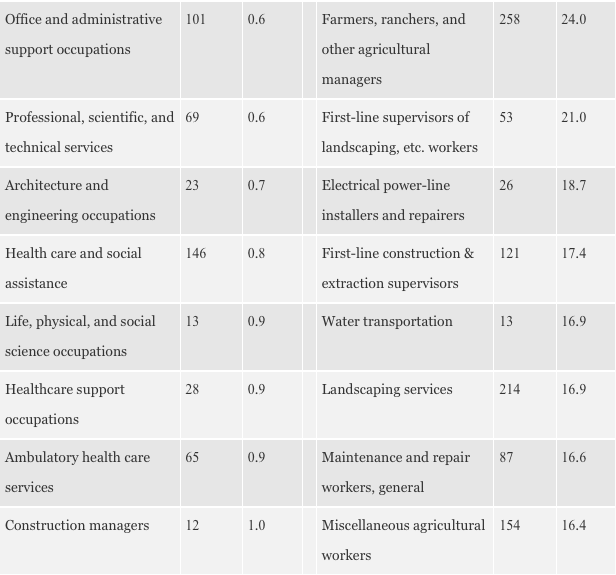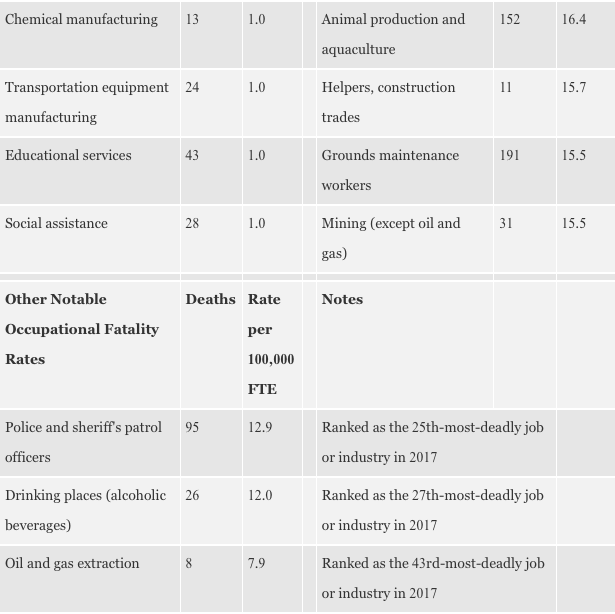The U.S. Bureau of Labor Statistics released its annual Census of Fatal Occupational Injuries on December 18, with the data likely being surprising to some people.
Looking at 139 separate occupations and discrete industries, an obvious pattern quickly emerges: the safest workplaces are indoors and the safest occupations frequently require education beyond high school. The most deadly occupations, on the other hand, are outside and often involve operating equipment. This largely drives the huge difference in workplace fatalities between men and women, with 4,761 men dying on the job compared to 386 women in 2017. The fatality rate for men was about 10 times that of women: 5.7 per 100,000 vs. 0.6 per 100,000 for women.
Working with computers, in hospitals, in business and finance as well as teaching, were the safest four fields in 2017, with fatality rates per hours worked about one-tenth of the national average of 3.5 workplace fatalities per 100,000 full-time worker equivalents (FTE).
On the other side of the ledger, the four most dangerous occupations were in commercial fishing, logging, aircraft pilots, and roofers. Regarding pilots and flight engineers, 59 died at work in 2017. That noted, air travel is far safer than other modes of transportation—most of these unfortunate deaths involved smaller aircraft such as helicopters, rather than large commercial airliners.
Thankfully for our first responders, police and sheriff patrol officers didn’t make the top-20 most dangerous professions in 2017. The Bureau of Labor Statistics cites 95 deaths in uniform for a rate of 12.9 workplace deaths per 100,000 FTE, placing law enforcement as the 25th-most-dangerous occupation in 2017.
Firefighters, on the other hand, suffered 34 fatalities in 2017 for a fatal workplace injury rate that was the closest to the overall national average of any of the 139 occupations or industries.
Many first responder fatalities happen in connection with responding to the scene—being in a moving vehicle is risky.
Bartenders and other employees in drinking establishments come in as the 27th-most-dangerous profession—showing that stupid stuff tends to happen around large amounts of alcohol.
The oil and gas extraction industry, once known for danger, saw a death rate of 8 per 100,000 workers in 2017, placing that industry as the 43rd-most-dangerous out of 139 occupations or industries. This fatality rate is a little more than double the national average.




Occupational fatality rates at the state level reflect the occupations in that state.
Alaska (10.2 per 100,000) and North Dakota (10.1 per 100,000) had the highest workplace fatality rates in 2017. Fishing, logging, and agriculture remain dangerous fields—yet essential if we want to eat and have shelter.
The safest states in 2017 were New Hampshire, New Jersey, and Rhode Island. As the construction trades, especially roofing, are relatively dangerous, the low rates of occupational fatalities in these states are likely due to the low level of new home construction there.
Another interesting comparison is to the military. The Bureau of Labor Statistics doesn’t include the military in its statistics. If it did, military service would generally rank as safer than fishing and logging but more dangerous than everything else. This holds true whether in wartime or peacetime as close to half of military fatalities happen during training accidents. Still, training death rates have declined by about half from 1980 to 2010 as lower cost and safer simulation has replaced largescale field exercises (the author was part of a desert exercise in 1989 with 10,000 soldiers operating tanks and other heavy equipment with three fatalities over the course of two weeks).
Occupational death rates by race and ethnicity reflect career choices as well as demographic concentrations in regions that tend to host high-risk jobs. The white (non-Hispanic) fatality rate was 3.6, just above the national average of 3.5, the black (non-Hispanic) fatality rate was 3.2, the Asian (non-Hispanic) fatality rate was 1.6, and the Hispanic fatality rate was 3.7.
We owe much of what we take for granted in our high standard of living to people willing to work in harsh and dangerous environments, whether pulling in crab pots in the Gulf of Alaska or roofing a two story house in the Texas summer heat.